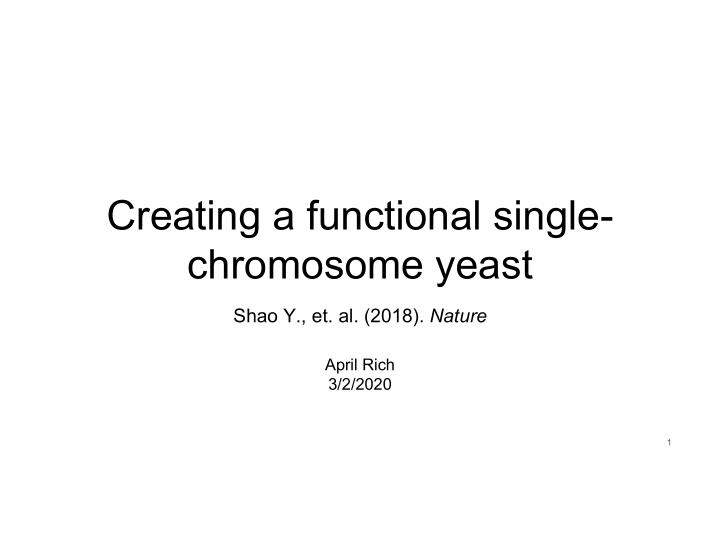



Creating a functional single- chromosome yeast Shao Y., et. al. (2018). Nature April Rich 3/2/2020 1
What’s in a number? Myrmecia pilosula Polyommatus atlantica n=1 n=224 2 https://en.wikipedia.org/wiki/Jack_jumper_ant Credit: Raniero Panfili
What’s in a number? Homo sapiens Protopterus aethiopicus 3.2 Gb, n=23 132 Gb, n=14 Credit: George Berninger Jr. 3
So what's the biological role of chromosome number? 4
So what's the biological role of chromosome number? Saccharomyces cerevisiae 12 Mb, n=16 Credit: Mogana Das Murtey & Patchamuthu Ramasamy 5
Liti, G. (2018). Nature news & views 6
Fusions BY4742/Wt SY0 SY1 … 14 chromosomes: 15 chromosomes: 16 chromosomes 12 native, 2 fused 14 native, 1 fused 7
Fusions SY6 SY12 … … … 9 chromosomes: 4 chromosomes: 2 native, 7 fused 0 native, 4 fused 8
Fusions SY14 SY13 SY12 2 chromosomes: 1 chromosomes: 3 chromosomes: 0 native, 2 fused 0 native, 1 fused! 0 native, 3 fused 9
SY14 - single chromosome strain ● Deleted roughly 0.2 Mb ● Single chromosome is 8x longer than longest native chromosome ● 1 centromere for 11.8 Mb XVI V VI XIV XII XII XV XI I II III IV VII VIII IX X 10
Fusion validation 11
Fusion validation SY2: fusion of I & II I II 12
Genome sequence ● Overall nucleotide sequence ordering preserved in SY14 fusion strain ● Fusion Introduced 11 SNPs and 7 indels 13
3D structure- HiC 2 native 16 native 2 fused 1 fused Chr #: 7 fused 14
2 native 16 native 2 fused 1 fused 7 fused 15
Directional preference 16
Changes in contact Single fused chromosome lost: ● 99.6 % of inter-chromosomal contacts ● 67% of intra-chromosomal contacts 17
2 native 16 native 2 fused 1 fused 7 fused 18
2 native 16 native 2 fused 1 fused 7 fused 19
transcriptome Only 28 genes, 0.5% of genes, were differentially expressed 20
transcriptome ● loss of adjacent telomere regions ● strengthening of retained telomere repression ● stress 21
Phenotype ● Size and shape similar 22
Phenotype ● Size and shape similar ● Slight reduction in growth rate 23
Phenotype ● Size and shape similar ● Slight reduction in growth rate ● Out-competed by WT 24
Reproduction ● Able to mate and produce diploid cells ● Diploid cells able to produce viable spores ● 2/6 diploid colonies had aneuploidy after mitosis 25
Reproduction ● Able to mate and produce diploid cells ● Diploid cells able to produce viable spores ● 2/6 diploid colonies had aneuploidy after mitosis ● Mating occurred between the two strains 26
So what's the biological role of chromosome number? 27
Conclusion ● SY14 single strain survived ● Single centromere for 11.8 Mb chromosome was still able to function during cell division ● Basically no change in gene expression ● Similar growth and phenotype to wild type ● 2/6 colonies tendency to form polyploidy- defects in chromosome segregation ● Reduced gamete production and viability in meiosis 28
Recommend
More recommend